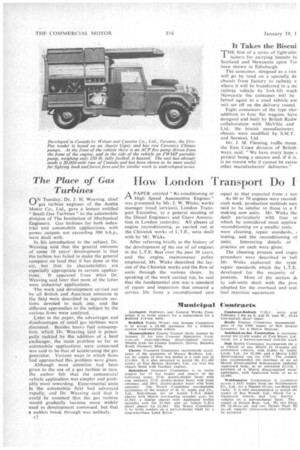How London Transport Do I
Page 40

If you've noticed an error in this article please click here to report it so we can fix it.
APAPER entitled "Re-conditioning of High Speed Automotive Engines" was presented by Mr. I. W. Wicks, works manager (road services), London Transport Executive, to a general meeting of the Diesel Engineers and Users Association in London yesterday. All phases of engine reconditioning, as carried out at the Chiswick works of L.T.E., were dealt with by Mr. Wicks.
After referring briefly to the history of the development of the use of oil engines in the L.T.E. fleet over the past 30 years, and the engine maintenance policy employed, Mr. Wicks described the layout of the Chiswick works and the flow of units through the various shops, In speaking of the work carried out, he said that the fundamental aim was a standard of repair and inspection that ensured a service life from a reconditioned unit equal to that expected from a nest
As 60 to 70 engines were recondi each week, production methods use{ said to be similar to those in a fi making new units. Mr. Wicks the dealt particularly with four se which he considered most applica reconditioning on a smaller scale. were cleaning, repair standartk, testing, and the reconditioning of units. Interesting details of : practice on each were given.
The cleaning process and engin procedure were described in full Mr. Wicks explained the syste repair standards which the L.T.E. developed for the majority of ponents. Most of the section di to sub-units dealt with the prot adopted for the overhaul and testi fuel injection equipment.












































































































